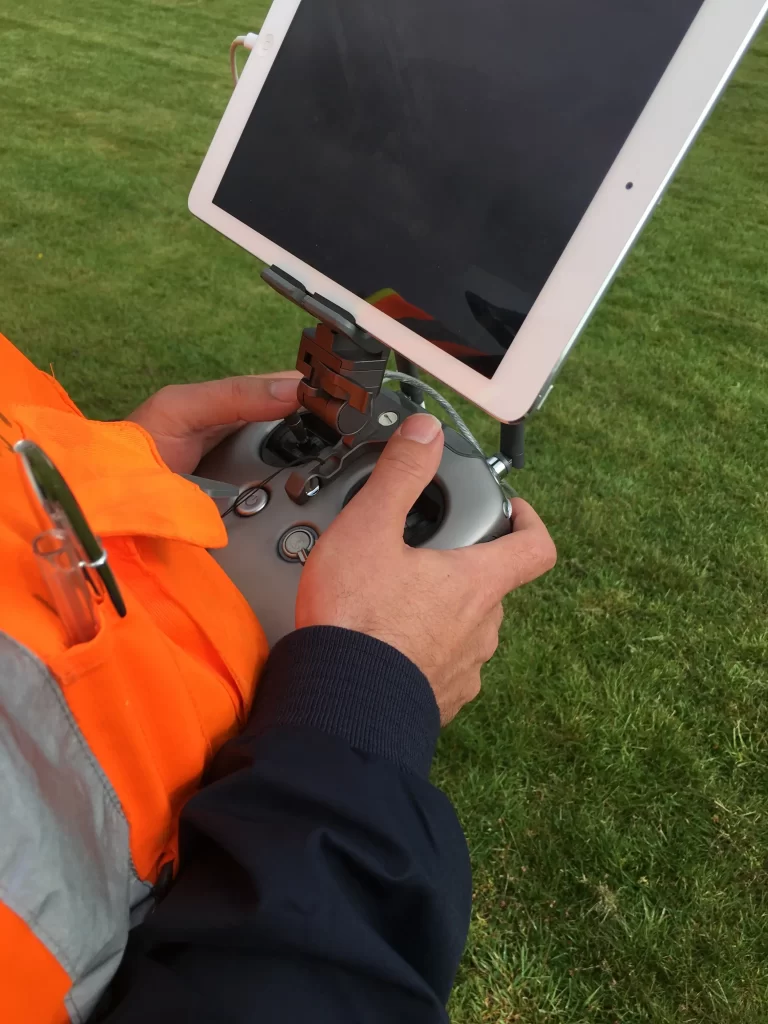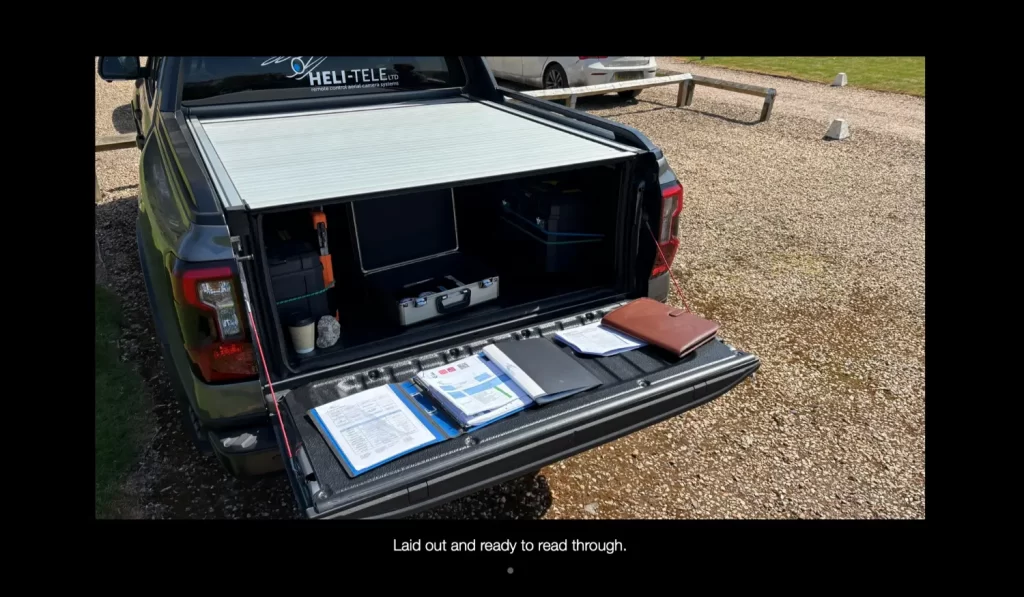Simon Adams – April 2025
So, here we are again. Put the kettle on, and grab some biscuits while you’re at it, as we may be some time.
I felt compelled to write this, as I see this in the field day in, day out. The Elephant in the field we very rarely talk about is Human Factors.
The Instructor in me.

For those of you who know me, and for those reading this that don’t, I’m in the privileged position of not only teaching people to fly drones but also taking people through their GVC practical flight test. Working alongside one of the biggest RAE’s in the country I meet all sorts of people from a wide range of backgrounds.
As the instructor, I feel it’s my duty to call out anything I notice when it comes to Human Factors. I probably wouldn’t see it in myself, so how can I expect the students to see it in themselves when they are under higher levels of stress? No one likes a test at the best of times.
When I take someone through their GVC flight test, to help me with this, I’ve set up my routine with Human Factors in mind.
All of the paperwork and flight plan are checked with the student at the back of my truck in the car park, with the tail gate down so I have space to lay everything out. We can go through all the paper work, drink coffee and chat about drones.
Yes, it’s a test, but it’s very much a lesson too. I am probably the first professional drone pilot they’ve spoken too, so it’s important we get off on the right foot. That way the whole session is more real world.
10 to 15 minutes in I get their real personality, and they get to know me. Now I have a student that is relaxed, calm and ready to fly. I get “them”.
If I ask a question, I get a full answer, they are engaged. I can see their enthusiasm for this great industry!
Phase one complete.
Once the paperwork and flight plan stage is completed, we head off into the field to carry out “The Job”. There’s a bit of role-play on my part here. I can talk about drones till the cows come home! I use this passion (some may say obsession!) to my advantage. I’m that annoying person that just won’t be quiet! All of this superfluous chat may lure them into a false sense of security and put them at ease, or it may knock them off their stride. For me, the latter is the aim, as it’s at this stage that Human Factors start to creep in.
As the stress starts to ramp up it’s the smallest things that start to create problems, things that at any other time wouldn’t be an issue.
Things that are done time and time again, with no problems whatsoever, are suddenly missed off completely.
The Human Mind
The human mind starts to do odd things, signs that stress is there.
Speech starts to speed up. Back at the truck I had a person that looked me in the eye, now I’m lucky if they look at me at all.
Basic procedures on setting up the drone get missed, or the answer to why isn’t clear.
Complex questions that deserve a complex answer are answered with either a yes or no, or nothing at all.
At this point I can help them snap out of it. I can help with setup and give gentle guidance, again helping them to calm down.
Remember the last thing I want to be is a witness to a crash! That can devastate a person for months, if not years.
So now the drone is finally in the air, the job has started and data is being collected.
The Human Body

It’s time for the human Body to take over.
The grip on both hands is so intense their hands starts to turn white. One or both hands start to shake. Maybe the thumb starts to shake.
If you are reading this and you fly drones (especially if your a creative pilot), I would argue you have to be particularly subtle when flying. Any bodily function that you can’t control is going to upset the drone’s movement, plus after time your brain will be worn out too.
As well as the hand shaking the next one is the controller roll, it’s almost like the pilot is trying to fly the drone using the controller like the steering wheel of a car.
I see this in people that haven’t flown for very long, are self taught and are often men. I talk about this later.
It’s like the eyes tell the brain that this is happening, the brain in its wisdom fires out a message to the fingers, but the arms in their enthusiasm take the message for their own and the fingers go stiff. Subsequently the drone isn’t moving as the eyes planed and so this repeats at 150mHz per second…and now the controller is rolling around in their hands.
A neck strap or shoulder harness may help in this case.
Another involuntary body movement that many people display is the “Body Roll”, leaning over to the side, their normal body posture has gone out of the window. They’re not standing straight any more.
Now I stand behind the student while they are flying, not only so I now have a body shield to protect me if the drone crashes into us (kidding!) but to see this part of Human factors play out. I can suggest to the student to put the drone into a hover and relax, take a deep breath and carry on once they have composed themselves and are happy to continue.
When I was at the start of my flying journey, I didn’t like anyone in my peripheral vision, everyone had to be behind me, not even beside me, if I could see them I felt uneasy.
Holding your breath, not blinking, a red rash starting from the chest and moving up to the face are other signs of stress.
I would say most of the people I give a Paul Hollywood style handshake to at the end of the test have clammy hands. Sweating, we see it in the movies, that close up shot of that bead of sweat rolling down the face of the film’s hero as they have to make that Go or No Go decision.
As I said before, I feel it’s my job to point out these sometime embarrassing things to the student, not to belittle them, but to highlight the Human Factors part of what we do.
The key thing here for me is the personality I had in the car park by my truck is not the same personality flying that drone, same person but now full of stress.
Just Culture
If you notice within yourself any of these stress factors I feel you’re half way there to sorting them out. We are all very different and Human Factors may present in many different ways.
It’s your job as professional crew, whether you’re the pilot, spotter, payload operator or safety officer to highlight/point this out when you see it, straight away, don’t hold back.
Again I would argue you know the people around you better than most because of the training you’ve all been through together, you’ll notice if someone is doing an impression of Joan Collins in the advert before she eat the Marathon – “Here!… You’re not yourself”!
Don’t turn a blind eye to this, the pilot could be a turn away from a crash. This is quite a big part of the GVC course, all the RAE’s spend a lot of time pushing this subject, don’t let that be the only time you spend on this subject. I find it fascinating to be honest.
If you have a read of some of the AAIB drone event reports, the number one reason for incidents are procedure related issues within an organisation, but a close second to that is Human Factors.
Our regulator is very hot at the moment (and rightly so too) about currency and training. This all plays its part. The AAIB will be able to work out very quickly the culture, or lack of, within any organisation. Spend time on this, speak to your peers, spend that time understanding each others personalty. You don’t need to psychoanalyse people, but if Joan Collins makes an appearance instead of your normally level-headed colleague, call her out! Don’t ignore the elephant in the field!
Reporting
As with Manned Avaiation we work very much within a Just Culture, we learn from our own mistakes and from the mistakes of others. That takes bravery and honesty, but it’s so important moving forward.
We want to stand next to Manned Avaiation holding our heads high, we’re operating in the same airspace. We work to high standards. We are professional operators.
Data, it’s all about data. If we have a problem with any part of our systems we have the European Co-ordination Centre for Accident and Incident Reporting Systems (ECCAIRS) to fall back on.
If we have an air infringement with another air user, we have the AIRPROX report, both of which are mentioned within our Operations Manual.
But how do we report a Human Factors issue?
CHIRP that’s how. I’ll put in a link to their site below and I would recommend adding CHIRP like you have with ECCAIRS and the AIRPROX report into your OM.
Think safe and happy landings.

CHIRP (Confidential Human Factors Incident Reporting Programme) is an independent charity dedicated to improving safety in the air and at sea. Our primary focus is to ensure that individuals involved in aviation and maritime can share their safety concerns and report close-call incidents and lessons learned through our confidential reporting service without fear of being identified or harming their careers. If they agree to us contacting stakeholders, we will follow-up with the relevant organisations to ensure that the right actions are taken at the right time.
At CHIRP, we believe in creating a ‘just culture’ and how it can help make aviation and maritime safer places to work.
Your voice matters. Confidential, voluntary reporting provides a vital safety net for collecting reports that would otherwise have gone unwritten. Each report we receive has the power to improve safety standards and practices, whether it is from the findings of one report or when combined with others to identify wider trends and safety issues. Our team of experienced professionals reviews every report we receive and we publish our anonymised findings to raise awareness of safety concerns and to encourage stakeholders to take action where necessary.
Quoted from CHIRP LinkedIn page.
Useful links and bedtime reading-
CHIRP
UK AAIB – Drones
https://www.gov.uk/aaib-reports?keywords=Drones
ECCAIRS
AIRPROX – It’s an App, down load from this link below.
https://apps.apple.com/us/app/ukab-reports/id1315589615?ls=1
